The Jedi High Council, simply known as the Jedi Council, was a body of twelve Jedi Masters that governed the Jedi Order. Headquartered in the Jedi Grand Temple on Coruscant, the High Council worked with the Galactic Senate to maintain peace and justice in the Galactic Republic. In addition, the High Council tracked the progress of the Jedi training of Padawans, deciding when the time was right for an apprentice to undergo the Jedi Trials in order to attain the rank of Jedi Knight, and from there, the rank of Master. The High Council also enforced the Jedi Code and traditionally selected its own members, including the Master of the Order who functioned as the body's elected leader. During the late Republic Era, legendary Jedi Masters, such as Mace Windu, Ki-Adi-Mundi, and Grand Master Yoda comprised the High Council.
The High Council adopted a leadership role in the Grand Army of the Republic as a result of the Clone Wars, working with Supreme Chancellor Sheev Palpatine and the Republic Military to defeat the Confederacy of Independent Systems in a pan-galactic conflict. However, relations between the High Council and Palpatine became strained during the war, especially after Jedi Knight Anakin Skywalker was appointed to the Council's ranks to represent the Office of the Chancellor. The revelation that Palpatine was actually Darth Sidious, the Dark Lord of the Sith, caused several members of the High Council to move against him in a failed attempt to prevent the Sith from returning to power. Most of the Jedi were subsequently purged from the galaxy, allowing Sidious to declare himself Emperor of the Galactic Empire in 19 BBY.
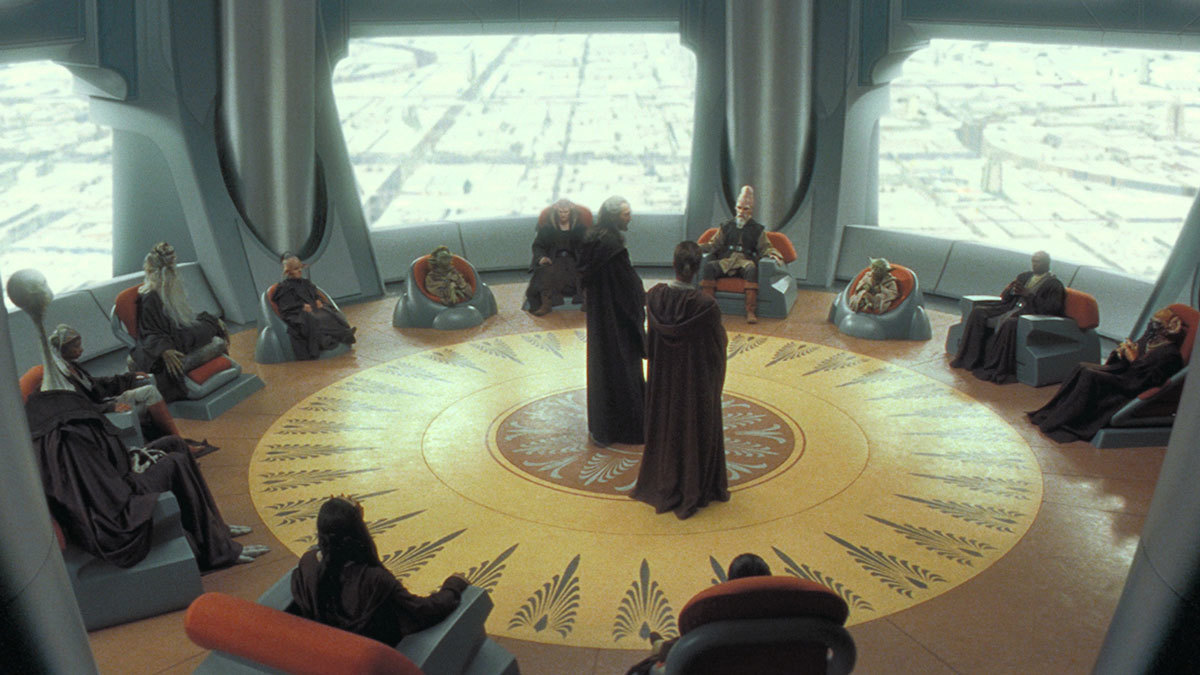
The Jedi Order was governed by a body of twelve Jedi Masters known as the Jedi High Council.
The Jedi High Council was the governing body of the Jedi Order. Its composition consisted of twelve Jedi Masters who were tasked with the responsibility of guiding the Order, including five members having life-long positions, who convened as a council to discuss matters of importance to the Jedi. The Council's activities included deliberating galactic events and discerning the will of the Force. If a Jedi elected to take a sabbatical from their Council duties, the member could select a Jedi to temporarily hold their seat in the Council.
In the last years of the Republic Era, the Council's ranks included two notable positions—the Grand Master and the Master of the Order. The Grand Master was an honorific bestowed on the oldest and wisest living Jedi, and the holder of the title served as leader of the Jedi Order. However, the title could be shared amongst several Jedi, as it had been during the High Republic Era. The Master of the Order was elected by the High Council to serve as their presiding officer. During the Invasion of Naboo in 32 BBY, Yoda held the title of Grand Master while Mace Windu served as Master of the Order. Both of these titles were held by Yoda during the time of the Clone Wars.
Jedi who served on the High Council had the authority to involve themselves in local political matters, whereas the rest of the Order required permission from the Council or the Galactic Senate. Members of the High Council could also leave its ranks at their discretion, as Jedi Master Yaddle did when she chose to relinquish her seat on the Council. Individual members could be removed from the High Council by their colleagues. In the event of a councilmember's death, their seat could be offered to another Jedi Master of the High Council's choosing.
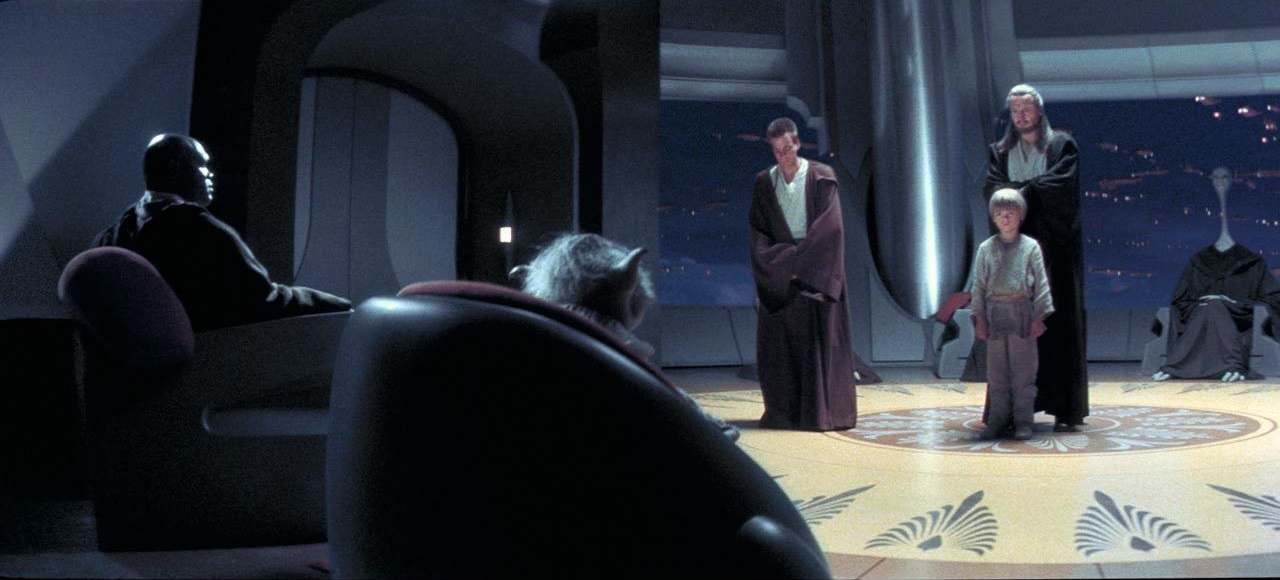
The High Council enforced the Jedi Code, a set of rules and disciplines that applied to the members of the Jedi Order.
The Council held the Jedi Code in the highest regard and required all Jedi to adhere to its principles. Members of the Council, such as Yoda and Windu staunchly adhered to the Order's ancient traditions. While the Council tolerated unconventional Jedi to an extent, there were tenets in the Code that they enforced without exception. When Qui-Gon Jinn offered to train Anakin Skywalker, the Council sternly reminded him that he already had a Padawan, Obi-Wan Kenobi, and that to train more than one apprentice at a time was forbidden by the Code. It was also the Council's prerogative to decide when a Padawan was fit to undergo the Jedi Trials, a fact which Yoda reminded Jinn when the latter attempted to circumvent the Code by promoting Kenobi in order to take Skywalker as his next apprentice.
Although it was known that some wayward Jedi used blasters, their use was never condoned by the Council. Kenobi, one of the last members of the Council, held a lifelong view that blasters were unreliable and uncivilized compared to the Jedi lightsaber.
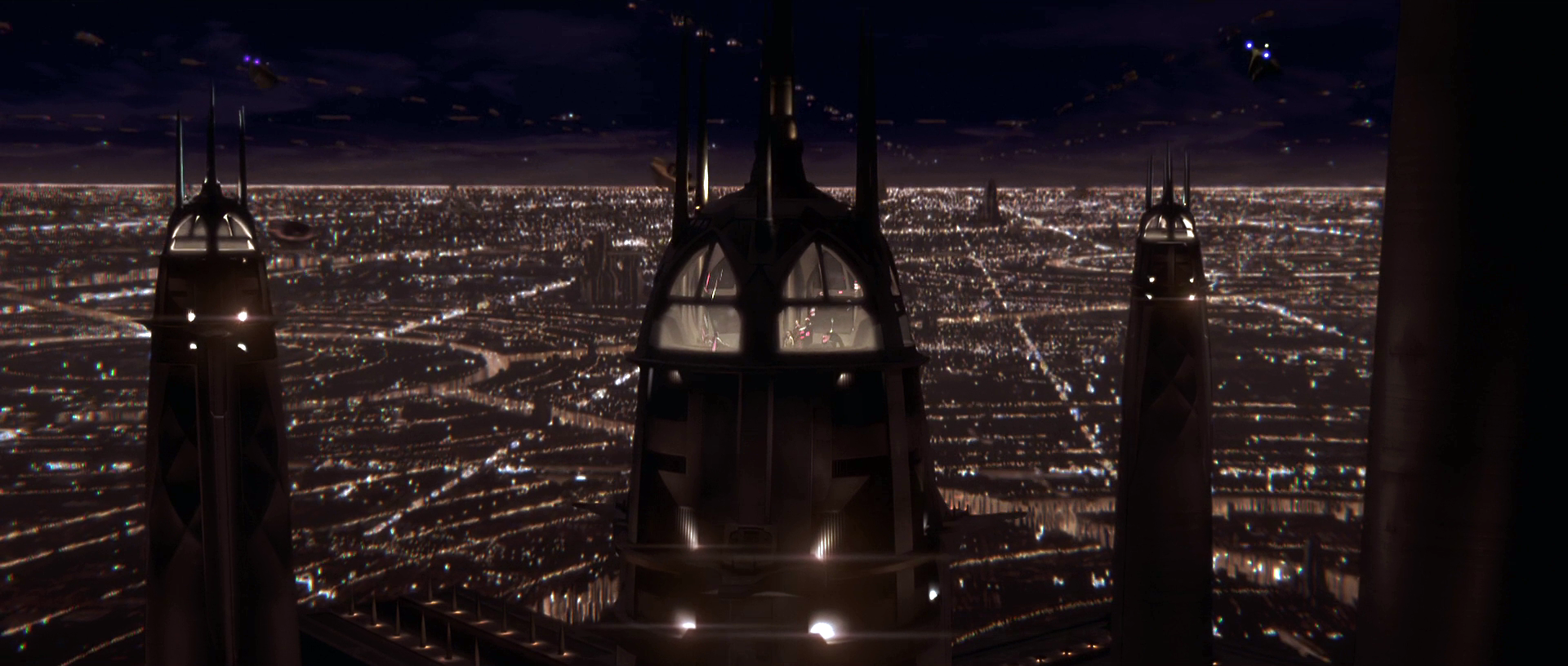
The Jedi Council Chamber was located in the High Council Tower of the Jedi Grand Temple on Coruscant.
The High Council resided in the Jedi Grand Temple, the most renowned Jedi temple in the galaxy. The Grand Temple was served as both a school and a monastery for the Jedi Order on Coruscant, the capital planet of the Galactic Republic, located in the Core Worlds. Before the Council was headquartered at Coruscant, the council was located at Alderaan and Ossus. The Temple ziggurat featured a "distinctive crown of five spires"—four Council Towers surrounding the main Temple Spire. One of the four spires was the High Council Tower which housed the Jedi Council Chamber. In addition, the Pinnacle Room, a chamber located at the top of the Temple Spire, served as a chamber of the High Council.
The Jedi High Council existed during the days of the Old Republic-era, during which a rogue Jedi rejected the ways of the light side on the belief that only the dark side of the Force could unlock one's true potential. The rogue Jedi's beliefs disturbed the Council, which exiled the individual. However, the rogue Jedi gathered a following and created a rival Force order, the Sith, during the Hundred-Year Darkness. The Jedi and Sith warred for countless generations until the final defeat of the Sith, which a Sith Lord named Darth Bane helped facilitate and escaped. Bane reformed the Sith under the Rule of Two, enabling the Sith Order to survive in secret over the next thousand years.
The High Republic Era was marked by the expansion of the Jedi Order's reach across the galaxy, in particular the Outer Rim Territories where they commissioned Starlight Beacon at the request of Supreme Chancellor Lina Soh. During that time, the title of Grand Master was shared between three Jedi: Yoda, Pra-Tre Veter, and Xo Lahru. All three Grand Masters served on the High Council, which included Jedi Masters Jora Malli and Stellan Gios, who took the seat on the Council once held by his master, Rana Kant. In 232 BBY, Yoda was on a sabbatical from the Council due to feeling the Force call him elsewhere. As such, Yoda stationed himself on the Padawan Academic Cruiser Star Hopper, where he helped train Padawans and younglings. He selected the Mon Calamari Jedi Master Ephru Shinn to take his place on the Council for the duration of his sabbatical.
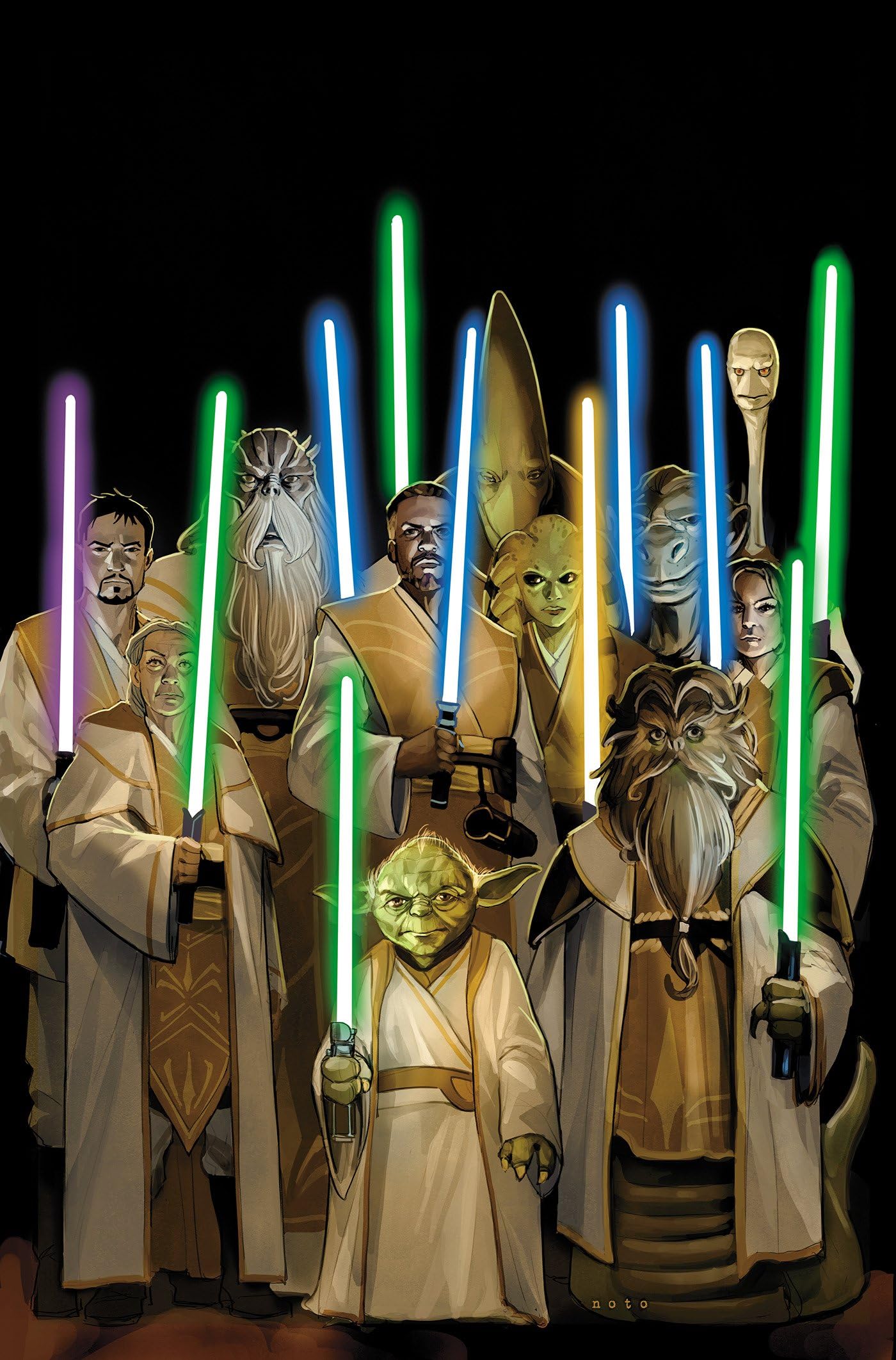
Eleven masters on the Jedi High Council of 230 BBY after another member, Stellan Gios, gave his life on Starlight Beacon.
During the Emergences in the aftermath of the Great Hyperspace Disaster, the Council realized that the Jedi may be needed in the Outer Rim more than they normally were. The Republic's exploration into the Outer Rim brought them as well as the Jedi into conflict with a group of marauders known as the Nihil. Grand Master Lahru convened the High Council to discuss the threat that the Nihil posed to the Republic. The Council came to the conclusion that the Jedi would help the Republic in the coming Battle of Kur, during which Malli was killed. Without Malli to fulfill the position, Grand Masters Veter and Yoda traveled to Starlight Beacon to confirm Jedi Master Avar Kriss' appointment as the space station's new marshal. Ry Ki-Sakka took Malli's place on the Council and even became a Grand Master at some point. After discovering the connection between the Nihil and the planet Dalna, where the Jedi had fought the Nameless species over a hundred years prior, Yoda went missing from the Order at large as he investigated the true nature of the threat the Republic and Jedi faced.
Despite the end of the Great Disaster crisis, the Nihil conflict would continue to drag out, which resulted in stronger ties between the Republic and Jedi Order. Soh and her aides grew increasingly willing to push themselves into Council meetings, which concerned Jedi Master Cohmac Vitus while he and various Jedi debated what ties their Order should have with the reigning government. In 230 BBY, Gios took Kriss's place as the Marshal of Starlight Beacon when she went off on an unsanctioned mission to the Great Hall of the Nihil. He gave his life during the destruction of Starlight Beacon at the hands of the Nihil to prevent the collapsing station from hitting the city of Barraza. Meanwhile, Yoda returned to the Jedi with news. The Eye of the Nihil Marchion Ro unleashed Nameless against the Jedi during the fall of Starlight, which convinced the Jedi to issue a recall of all Jedi back to Coruscant while they determined how to fight the Nameless. In 229 BBY, Grand Master Veter was executed by the Nihil on a broadcast shown to the galaxy. The following year, Jedi Master Elzar Mann was offered to take Gios' empty seat on the Council. Mann ultimately declined the offer as he believed the role did not suit him and that it was not the right place for him when he considered where he was meant to be with the living Force, instead knowing it was with Kriss, after she had told him that she loved him.
During the final years of the Galactic Republic, the upper tier of the Jedi High Council consisted of legendary Jedi Masters, such as Yoda, the oldest and wisest of the Jedi; Ki-Adi-Mundi, a Cerean alien with a binary brain; and Mace Windu, the staunch traditionalist and champion of the Jedi Order.
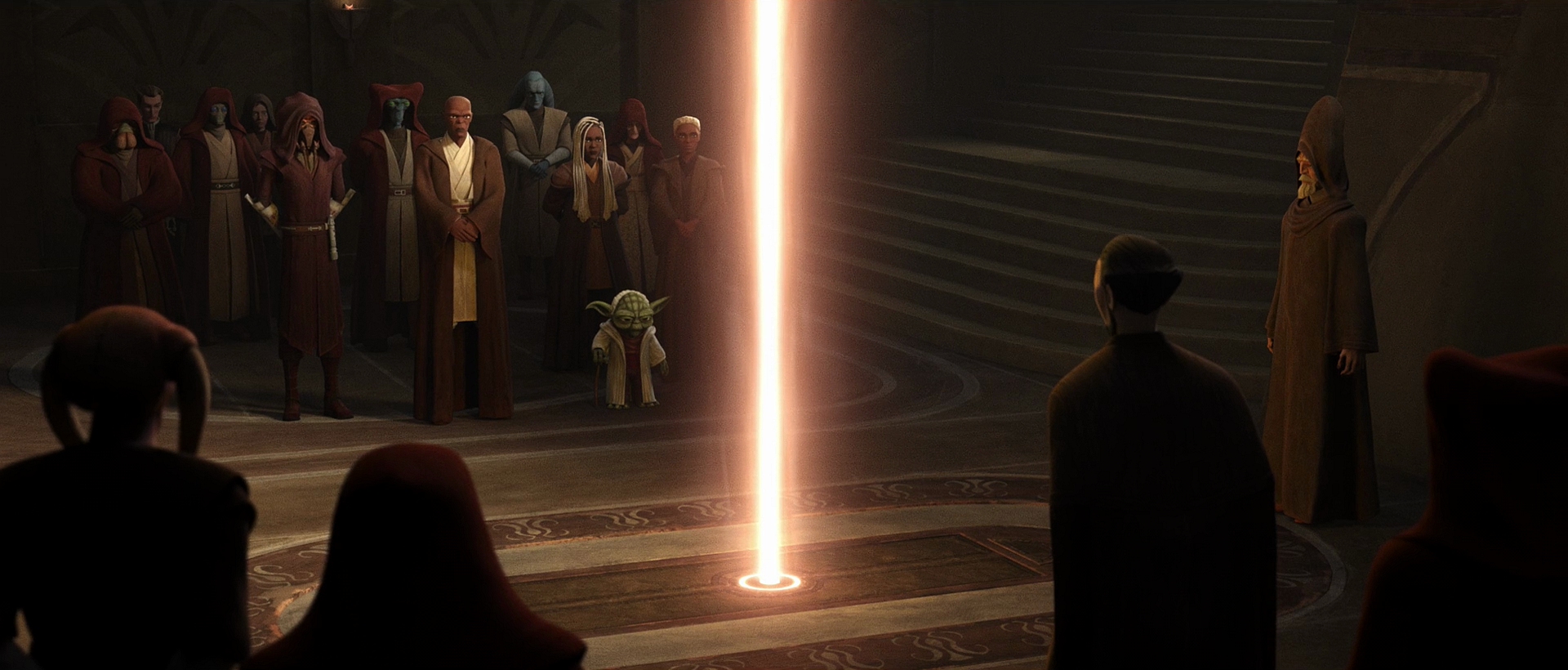
Mace Windu was offered a seat on the High Council after the death of Master Katri.
Windu joined the ranks of the High Council as a replacement to Jedi Master Katri, who was killed while on an on the planet Raxus Secundus. The High Council had Jedi Masters Windu and Dooku to retrieve Katri's body. While Windu adhered to the protocols of their role as Jedi, Dooku insisted on investigating Katri's death and discovered that she had been killed by the bodyguards of Senator Larik, who was fatally shot in the ensuing skirmish between the Raxians and the Jedi. After the funeral of Katri, the High Council invited Windu to take Katri's seat.
By around 40 BBY, Jedi Master Qui-Gon Jinn was offered a seat on the High Council, an offer that was agreed upon by all of the Council members at the time but Yoda. Jinn's views had long been considered controversial and Jinn took the offer as a sign that perhaps the Council was becoming more open to new ideas. Following Jinn's rogue actions in regards to the coronation of Queen Fanry of Pijal, the Council considered withdrawing its offer, but decided that the offer would stand. Jinn, however, felt that the Force was leading him along a different path and chose to reject the offer, something which he suspected had not happened for hundreds of years.
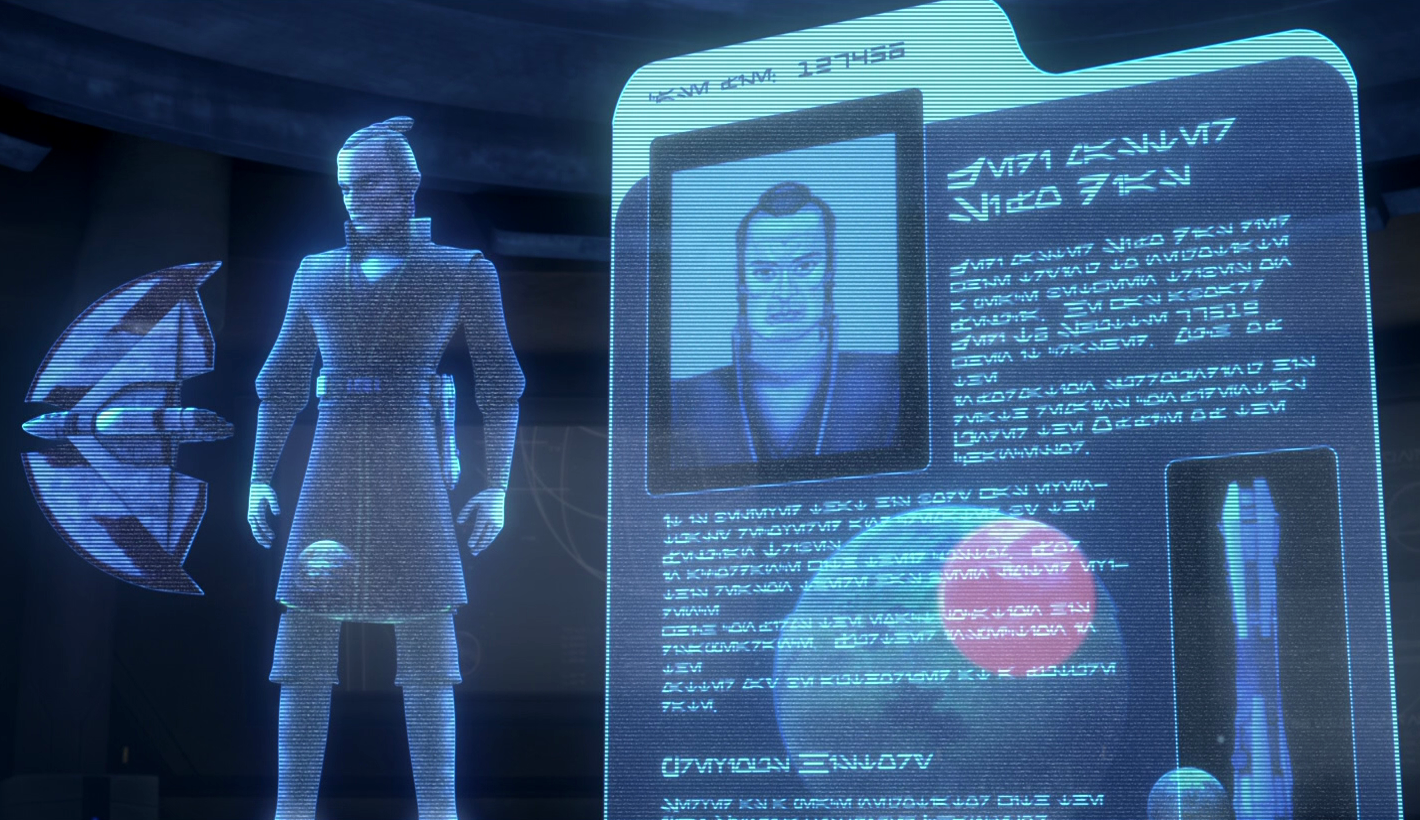
Unbeknownst to the High Council, former councilmember Sifo-Dyas ordered the creation of a clone army to defend the Galactic Republic.
Prior to the blockade of Naboo by the Trade Federation, Jedi Master Sifo-Dyas was removed from the High Council following several notable instances in breaching procedures in recruitment of Jedi candidates and for advocating the creation of an army for the Republic's protection, believing that the galaxy was on the brink of war. In spite of his removal from the Jedi Order's ruling body, Sifo-Dyas secretly commissioned the Ruling Council of Kamino to engineer an army of clone soldiers. The Kaminoans accepted the contract under the belief that the Jedi Master acted on behalf of the Republic. However, Sifo-Dyas' plans factored into the agenda of the Sith, who co-opted the clone trooper project after arranging the death of Sifo-Dyas by the Pyke Syndicate. In addition, the Dark Lord of the Sith Darth Sidious used Dooku's disillusionment with the Jedi Order and the Galactic Republic to sway him to the Sith cause. Dooku used Sifo-Dyas' access code to erase all information about Kamino from the Jedi Archives and was instrumental in bringing the Kaminoan clone army under the Sith's influence.
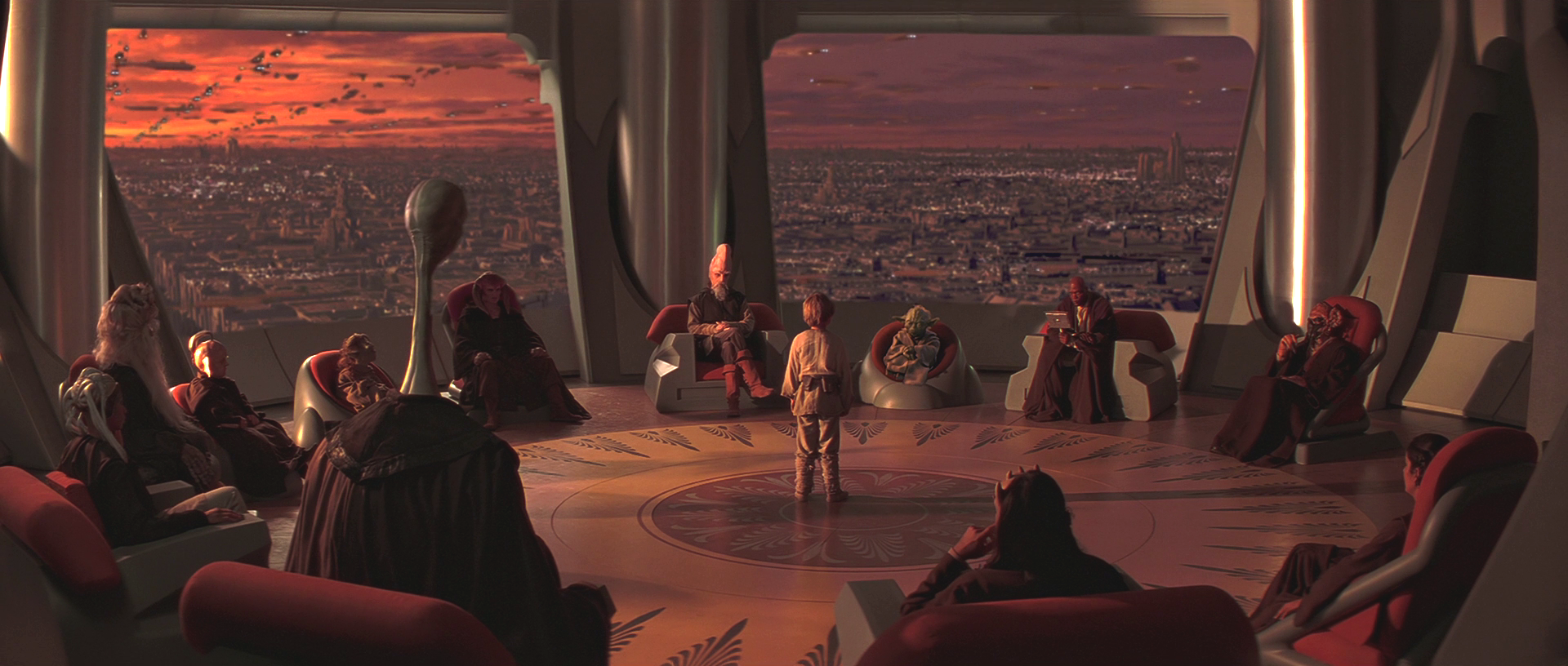
Anakin Skywalker, the Chosen One, was taken to the Jedi Temple on Coruscant to be evaluated by the High Council.
In 32 BBY, Jinn reported two revelations to the Council—the return of the Sith, who the Jedi had not encountered for over a millennium; and the discovery of Anakin Skywalker, a prodigy of the Force whom Jinn deemed the Chosen One of Jedi prophecy. The Council was skeptical of the maverick Jedi's claims, however. Nevertheless, they decided to commit their resources to discovering the identity of the dark warrior who attacked Jinn on Tatooine. Moreover, they agreed to meet with Skywalker in order to gauge his abilities in the Force. Though the former slave proved exceptionally powerful with the Force, Yoda sensed a considerable degree of fear within him, noting that fear was a path to the dark side of the Force. Windu also felt that Skywalker was too old to commit himself to the ways of the Jedi and the Force without being distracted by his emotional attachments. As a result, the Council turned down Jinn's request to train Skywalker.
The Council ultimately reversed their decision after Jinn perished in a duel against Darth Maul, the Sith Lord who attacked him on Tatooine. In addition, Skywalker's heroic actions at the Battle of Naboo convinced the Council to accept him into their ranks as the Padawan of the newly-promoted Jedi Knight Obi-Wan Kenobi, Jinn's former apprentice. Despite this, Windu remained wary of Skywalker, as did Yoda who feared that Skywalker's training posed great danger to the future of the Jedi Order. Jedi Master Yaddle resigned her seat on the High Council following Jinn's death on Naboo. She later died at Dooku's own hands after informing him as such, unable to sway him back to the light despite her sympathies. By killing Yaddle, Dooku became Sidious' new Sith apprentice and adopted moniker "Darth Tyranus."
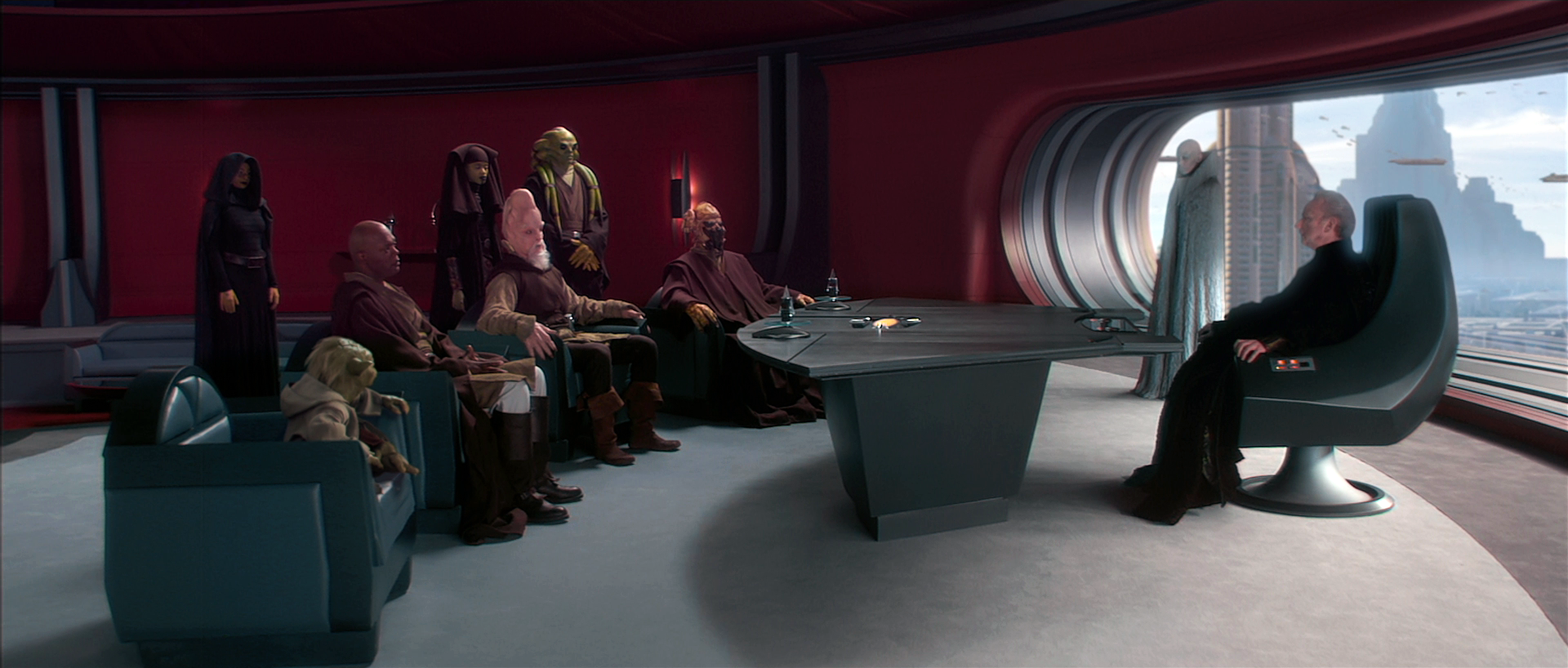
The High Council advised Supreme Chancellor Sheev Palpatine during the Separatist Crisis.
In the aftermath of the Battle of Naboo, the galaxy experienced increasing political turmoil and instability as thousands of star systems joined a growing secessionist movement in opposition to the rule of the Galactic Republic. As both sides drew inexorably towards war, the Jedi Council consulted with Supreme Chancellor Sheev Palpatine. Owing allegiance to the Galactic Senate, the Jedi were duty-bound to protect the citizens of the Republic. However, Windu noted that the Jedi did not possess the adequate manpower to defend the entire Republic in a pan-galactic war. Around the same time, the life of Naboo Senator Padmé Amidala was threatened by an assassination plot, leading the Council to assign Kenobi and Skywalker to her protection detail at the chancellor's request.
Kenobi and Skywalker prevented Amidala's assassination and captured her attacker, Zam Wesell, but the bounty hunter was killed by her partner, Jango Fett, before she could reveal his identity to the Jedi. In light of the second attack on the Naboo senator, the High Council ordered Kenobi to personally investigate the bounty hunter who hired Wesell. Skywalker was instructed to escort Amidala back to her homeworld as her bodyguard throughout the investigation. As leader of the political opposition to the Military Creation Act, Amidala was reluctant to leave the galactic capital of Coruscant while the Senate debated the creation of a Republic Military. Skywalker requested Chancellor Palpatine's assistance on behalf of the High Council, to which the chancellor obliged by issuing an executive order compelling Amidala to return to Naboo for her safety.
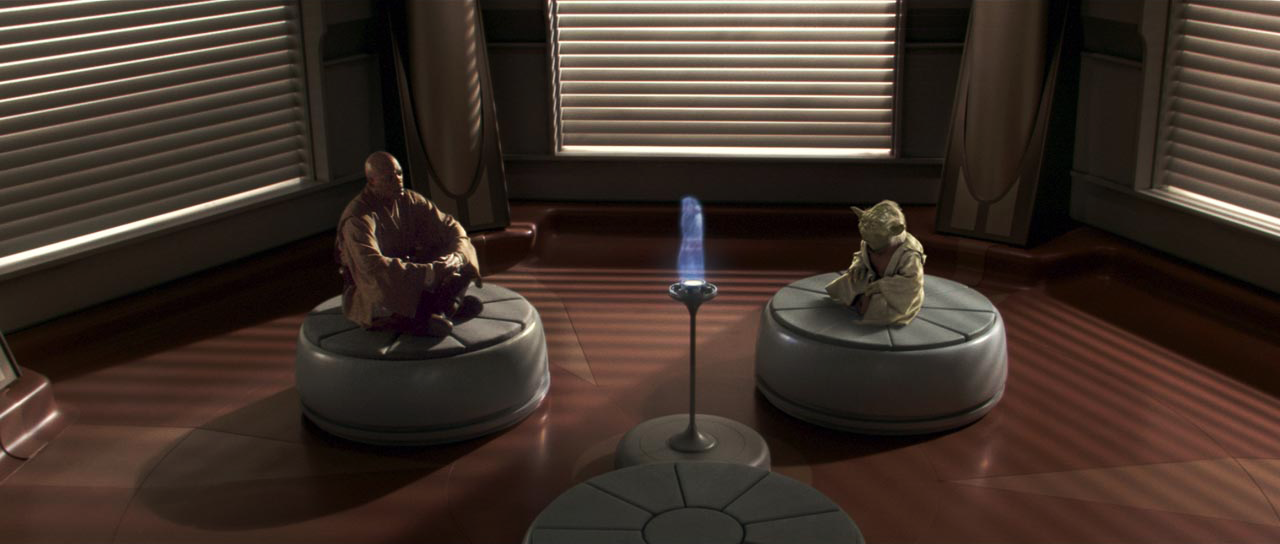
The High Council discovered that the late Sifo-Dyas secretly created a clone army without their approval.
The search for Jango Fett led Kenobi to the extragalactic world of Kamino, where he discovered the clone army that had been bred over the last decade by Kaminoan scientists. Prime Minister Lama Su revealed that the late Jedi Master Sifo-Dyas commissioned the Kaminoan government to create the army approximately ten years before Kenobi's arrival in Tipoca City. Kenobi also learned that the bounty hunter he sought was the clone army's genetic template. He communicated his findings to Yoda and Windu, who confirmed that the High Council did not authorize the creation of clone troopers. They took Kenobi's discovery as evidence of that the Jedi's connection to the Force was diminished, having been unable to foresee the creation of a clone army. Although Windu considered informing the Senate, Yoda argued that it would only compound their situation further, forcing the High Council to contend with more adversaries in addition to the Dark Lord of the Sith.
Fett left Kamino with his cloned son, Boba Fett, after Kenobi tried to apprehend him. Kenobi pursued the Fetts to Geonosis and consequently discovered the Separatist Droid Army, an army of battle droids secretly built for the newly formed Confederacy of Independent Systems. The High Council and the Galactic Senate received Kenobi's report about the droid army's development on the Geonosian homeworld as well as the Confederacy's plans for war under the leadership of the former Jedi-turned-Separatist Head of State, the Count of Serenno Dooku.
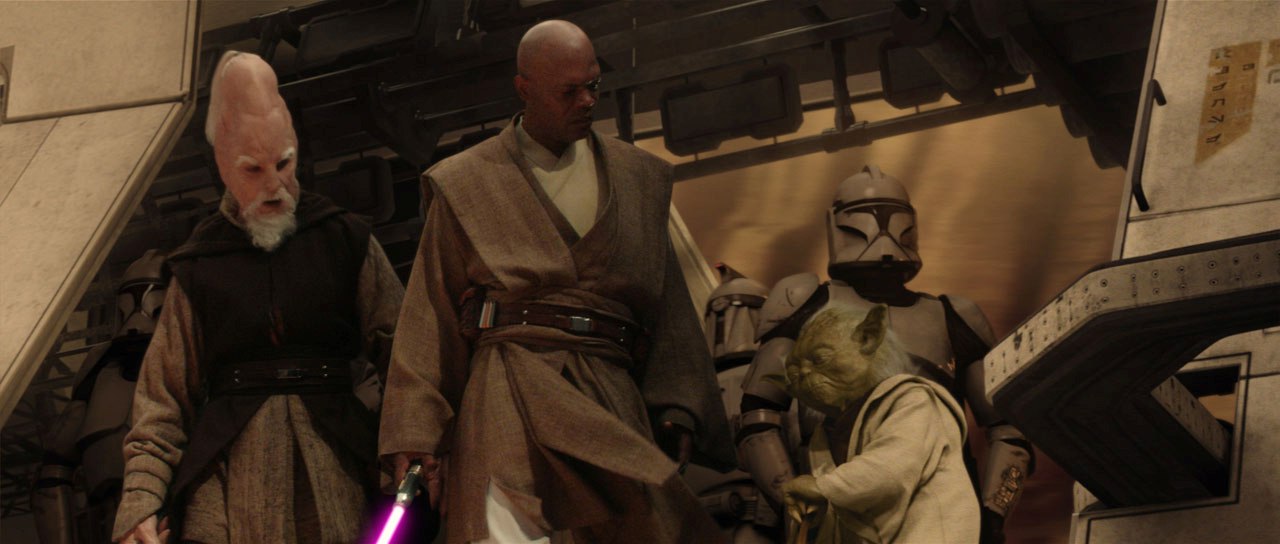
Under the High Council's leadership, the Grand Army of the Republic achieved its first victory in the Battle of Geonosis.
After the Senate empowered Chancellor Palpatine to take control of the clone army, the High Council formed a plan to decapitate the Separatist movement before it could escalate into a pan-galactic war. Windu would lead a Jedi assault team to aid Kenobi on Geonosis while Yoda traveled to Kamino to see the clone army for himself. The newly formed Grand Army of the Republic launched a pre-emptive strike against the Separatist forces on Geonosis, where the clones achieved "air and ground supremacy against formidable odds under the skillful leadership of the Jedi Council." During the initial battle, Jedi Council member Coleman Trebor was killed by Jango Fett when he attempted to confront Dooku. Fett was killed, in turn, by Windu. The Republic ultimately succeeded in driving the Separatists into a full retreat, but the First Battle of Geonosis only marked the beginning of the Clone Wars in 22 BBY.
Following the death of Coleman Trebor, the High Council began to rotate different Jedi into his seat without confirming if the rotation method would be a permanent assignment for the new Council members, or simply something born out of the chaos of the quickly growing Clone Wars. By the time of the Cadesura disaster, Kenobi was given Trebor's seat, but he was unsure if the assignment would be temporary. While he was honored, he was unsure if he had the experience for such a position. Nevertheless, after his actions during the mission to Cato Neimoidia, it was decided his seat would be permanent.
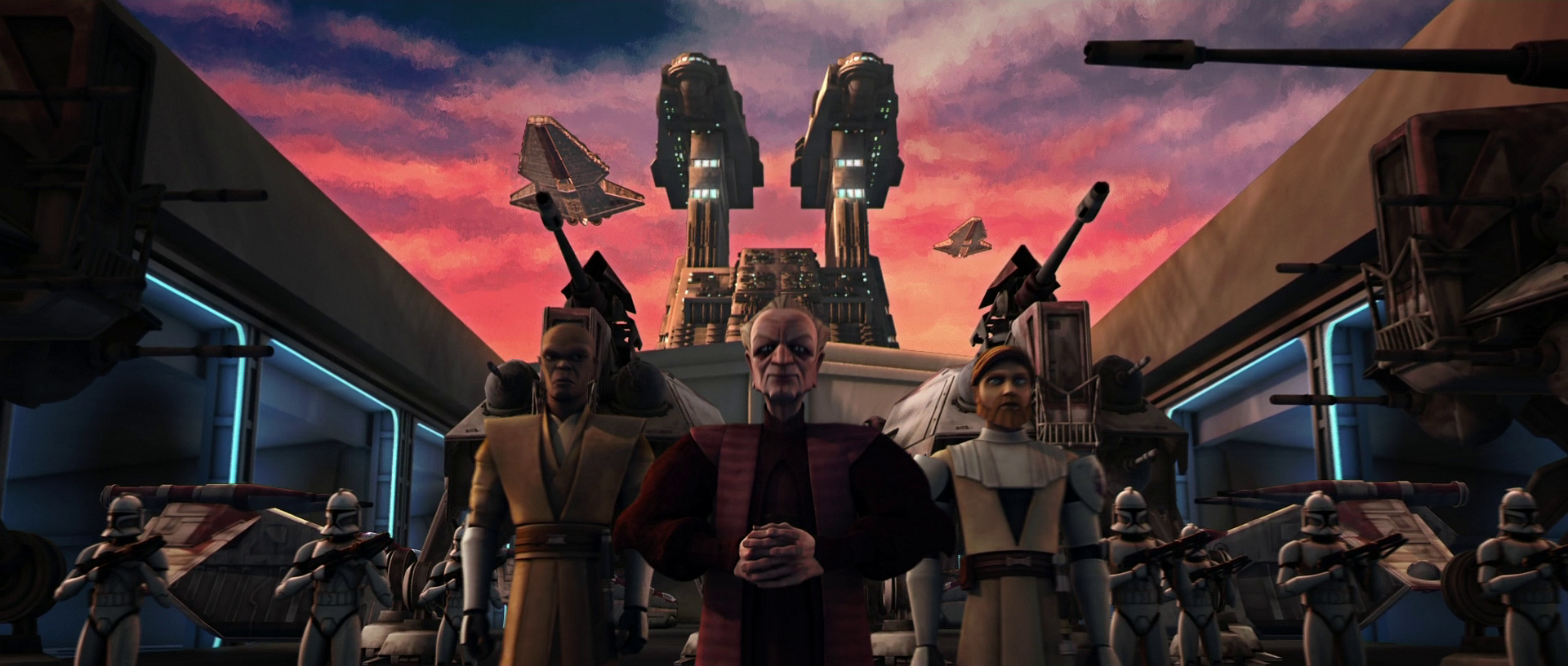
Throughout the Clone Wars, the High Council led the Republic's war effort under Chancellor Palpatine.
Throughout the conflict, the Council led the war effort in their capacity as Jedi Generals of the Republic Military. Members of the Council, such as Windu, spent much of their time on Coruscant, directing the Jedi in their new role as military leaders while simultaneously coordinating strategy with the Office of the Chancellor. At times they also participated more directly by leading clone troopers into battle on various planets across the galaxy, including Christophsis, Ryloth, and again on Geonosis. Despite committing to their wartime responsibilities, the Council continued to serve as emissaries of the Republic; from bringing neutral worlds, such as Toydaria into the Republic's fold, to healing the ancient rift between Bardotta and the Jedi Order, the Council served as both diplomats and generals in their efforts to protect and preserve the Republic.
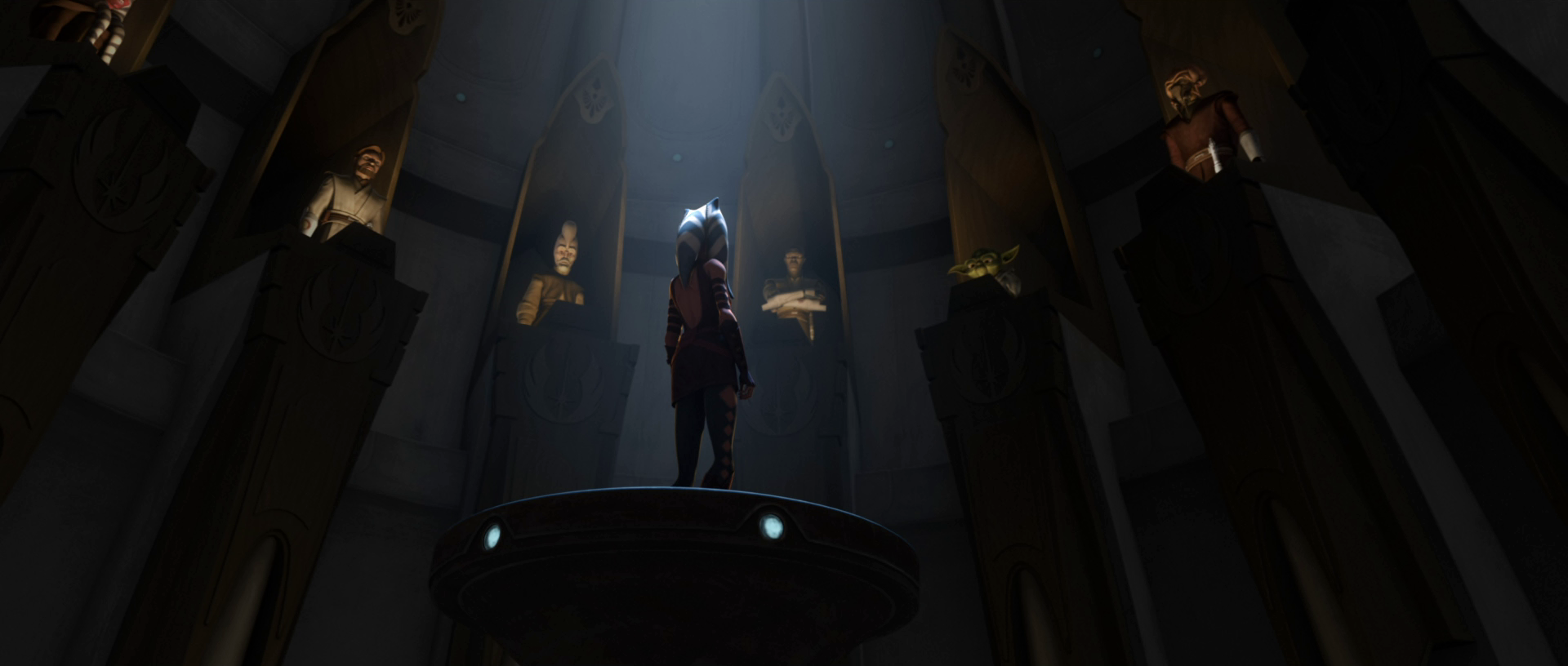
The High Council expelled Ahsoka Tano, who was accused of treason against the Galactic Republic.
At the height of the Clone Wars, the Jedi Temple on Coruscant became the target of a terrorist attack that resulted in the bombing of the Temple hangar—an act which killed several Jedi, as well as civilians and clones. Alarmed by the assault on a sacred site of the Jedi Order, the Council assigned Skywalker and his apprentice, Ahsoka Tano, to investigate the incident. However, Tano was soon framed for the death of Letta Turmond, a terrorist whom she captured during the initial investigation. After Tano was apprehended and brought back to the Temple, the Council was requested by the Senate to expel her from the Order, believing that an internal Jedi trial would lack impartiality. In addition to revoking her Jedi status, the Senate insisted on having Tano transferred to military custody so that she could be made to stand trial for acts of treason against the Republic.
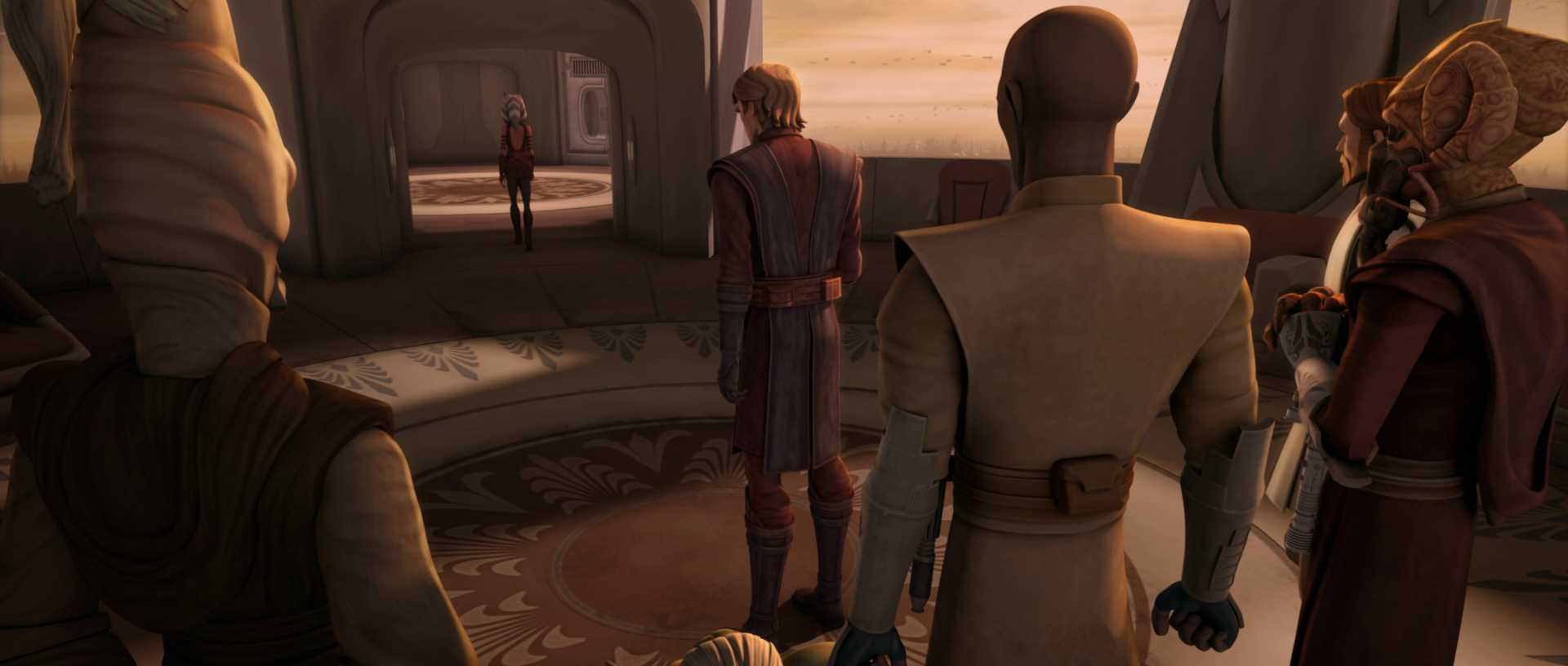
After the trial, Tano rejected the High Council's offer to rejoin the Order.
Following a debate, the Council concluded that there was sufficient evidence to convict Tano as a traitor to the Republic. Additionally, Windu asserted that protecting Tano could be regarded as an act of opposition to the Senate. Though it was not a unanimous decision, the Council chose to comply with the Senate and expelled Tano from the Order, turning her over to a Republic military tribunal. During the trial, Tano was defended by Senator Padmé Amidala and prosecuted by Admiral Wilhuff Tarkin, who advocated the death penalty for Tano. Ultimately, Tano was cleared of all charges after Skywalker discovered the real traitor: Tano's friend and fellow Padawan Barriss Offee, a fallen Jedi who believed that the Order was too violent and that the Republic on the verge of becoming a failed state. In light of Tano's innocence, the Council apologized, with Plo Koon admitting that they were wrong to accuse her of disloyalty. Mundi, Tiin, and Windu observed that she had passed a great trial in her training, making her a greater Jedi in the process. The Council offered to welcome her back into the Jedi Order, but to their surprise and Skywalker's dismay, Tano rejected the offer and instead chose to search for a new path in life, damaged by the Council's collective lack of faith in her.
Though preoccupied with the Clone War, the High Council conducted a secret investigation into Sifo-Dyas' death after his lightsaber was found by Jedi General Plo Koon. The Council was disturbed to discover that the Sith participated in the creation of Sifo-Dyas' clone army. While the Council did not understand why their enemy provided the Jedi with the means to defend the Republic, Windu noted with caution that such a revelation would undermine public confidence in the Jedi, the Republic, and the war effort. Citing the valiant service and loyalty of their clone soldiers, as well as the need to bring a swift and decisive end to the war, Yoda declared that the Council would not inform anyone, even the chancellor, of the Sith's involvement in the origin of the clone army.

Puzzled by a great mystery, Yoda sought the aid of his fellow Masters on the High Council.
As the Council investigated the Sith's role in the clone army's creation, Yoda revealed to his colleagues that the spirit of Qui-Gon Jinn communicated with him from beyond death. However, everything the Jedi knew about the Force suggested that the ability to retain one's own identity after death was impossible. As such, their reactions ranged from concern to skepticism and suspicion. Kenobi believed that Yoda was simply under duress due to the war, but Mundi opined that the ancient Jedi Master was possibly falling to the influence of the dark side. With the Council unable to reach a consensus on Yoda's mental well-being, Windu ordered the Jedi Temple Guard to monitor his activities as a precaution. With Skywalker's assistance, Yoda escaped from the Jedi Temple, embarking on a quest that ultimately led to his discovery of the ability to preserve his identity after becoming one with the Force.
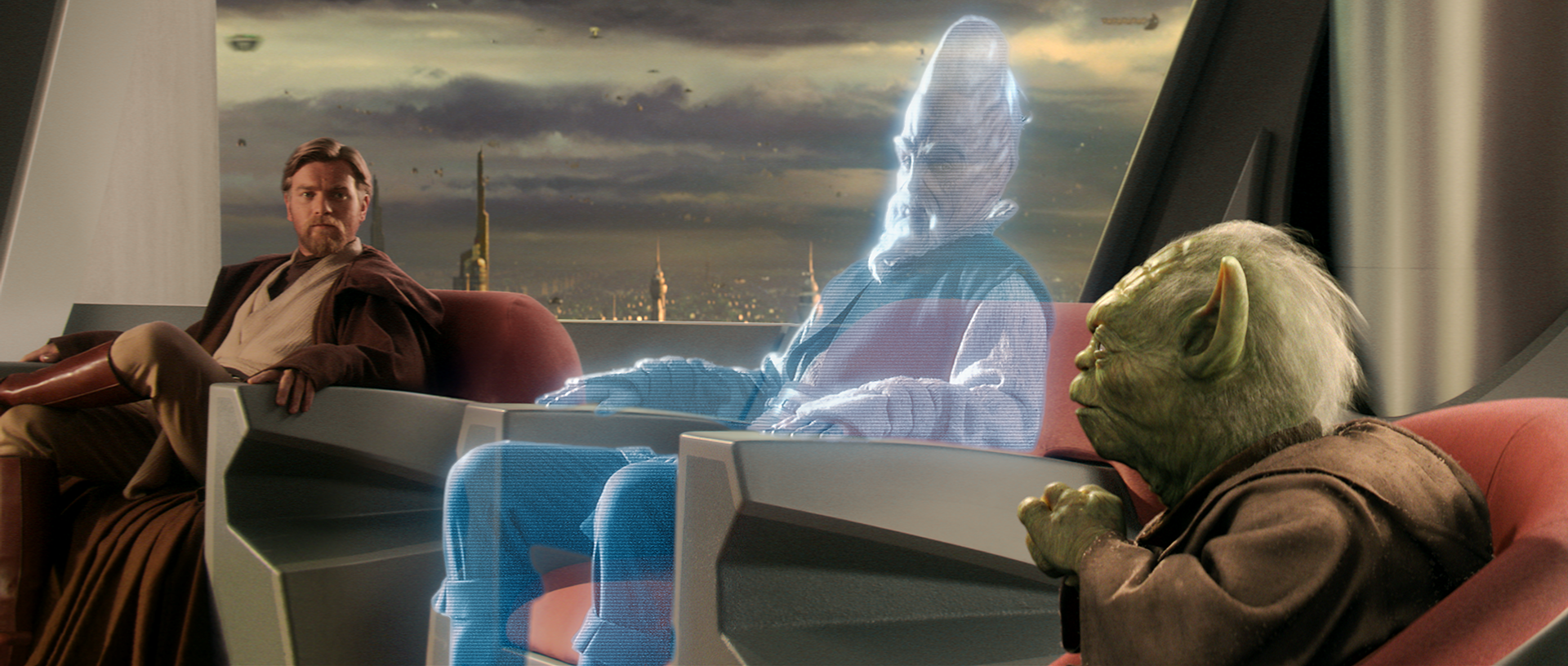
The Mahranee massacre pushed the High Council to adopt a plan to assassinate Count Dooku.
By 19 BBY, almost three standard years after the first battle of the Clone Wars, the Republic loyalist world of Mahranee was conquered by a Separatist invasion force. After claiming the planet and its resources for the Confederacy, Count Dooku ordered the deaths of all Mahran refugees before they could be evacuated from their fallen homeworld. Dismayed by the recent Mahran genocide, the Jedi Council resolved to the end the conflict once and for all by assassinating Dooku. Though Kenobi initially objected to the method of assassination, Windu stressed that it was the Council's obligation to utilize every option at their disposal for the sake of the Republic and its citizens. Windu's argument, combined with the Jedi's duty to the Republic, convinced the Council to sanction the mission. On Kenobi's recommendation, they assigned the task to the maverick Jedi Master Quinlan Vos due to his experience with covert assignments.
In addition to Vos, the Council determined that Dooku's former apprentice, Asajj Ventress, was also critical to the success of the mission. To that end, Kenobi tasked Vos with gaining Ventress' trust in order to ultimately secure her support against Dooku. However, despite earning her respect, Vos' relationship with Ventress became increasingly personal, leading the former to break his Jedi vows and move closer to the dark side of the Force.
After losing contact with Vos for a time, the Council learned from Ventress that not only had the mission failed, but Vos was also taken as a prisoner of Dooku. Though she was regarded with suspicion by the Jedi, particularly Windu and Skywalker, who blamed her for the failure of the mission, the Council offered to grant her amnesty in return for her cooperation in the rescue of Vos. Together with Dooku's former acolyte, the Jedi successfully retrieved Vos, although Ventress was convinced that he had fallen to the dark side by becoming the count's new disciple. The Council initially did not share Ventress' suspicions, but nonetheless pardoned her in accordance with their arrangement.
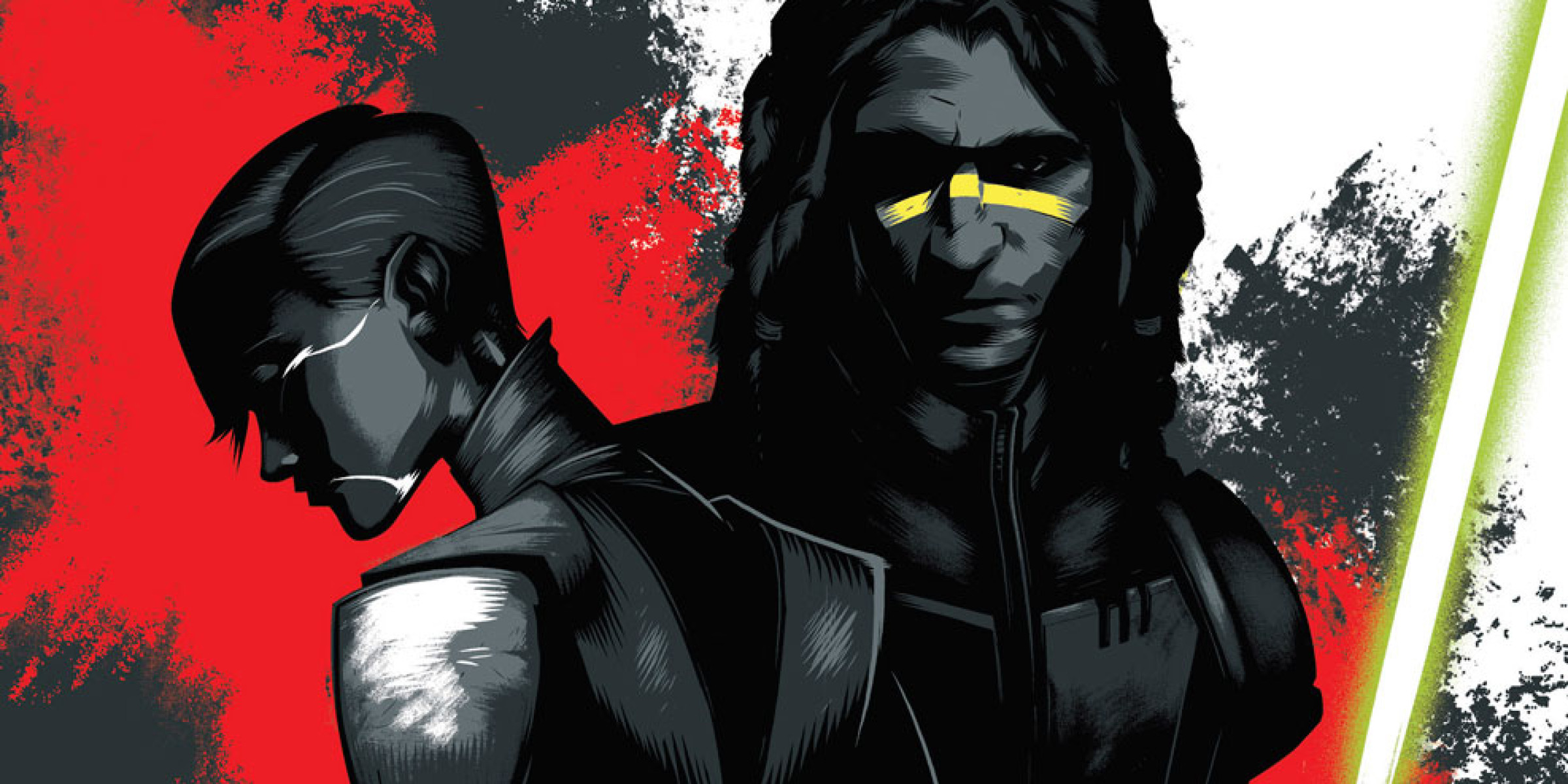
The High Council's agent, Quinlan Vos, recruited Asajj Ventress for the mission to kill Dooku.
Vos's deception did not last long, however. Yoda, who began to suspect that Vos had indeed become a traitor, came to sense the dark side within him. At Windu's suggestion, the Council considered having him executed, but after pleas from Kenobi, they dispatched Vos to make a second attempt on Dooku's life as a test of loyalty. They also reluctantly agreed to allow Ventress to participate in the mission after she revealed that the count was scheduled to travel to the planet Christophsis. At the same time, Kenobi was instructed to execute Vos if he revealed himself as a traitor to the Jedi and the Republic.
While Dooku ultimately survived the Jedi's second assassination attempt, the Council learned that Vos had embraced the dark side and committed several acts of treason, including the murder of two Jedi—Akar-Deshu and Kav Bayons. However, Vos renounced the dark side and took responsibility for his actions after Ventress saved his life by sacrificing her own. With some persuasion from Kenobi, who argued that the decision to assassinate Dooku was morally wrong and the cause of Vos' fall, the Council forgave Vos by welcoming him back into the fold of the Jedi Order.
During the Battle of Coruscant, Count Dooku was killed by Anakin Skywalker. With the death of the Confederate head of state, the remaining Separatist leaders fled into hiding while command of the battle droid army passed to General Grievous, making him the next high-profile target of both the Republic and the Jedi Order. Palpatine assured Windu that the Senate would vote to continue the war as long as the general remained alive and free, to which the Jedi Council responded by prioritizing the hunt for Grievous. By now, the relationship between the Council and the chancellor had grown increasingly strained; Palpatine's gradual accumulation of wartime powers only raised their suspicions. Though they initially accepted the chancellor's empowerment in order to quickly mobilize the clone army for war, the gradual expansion of his control over the Republic caused the Council to become wary of Palpatine's motives.
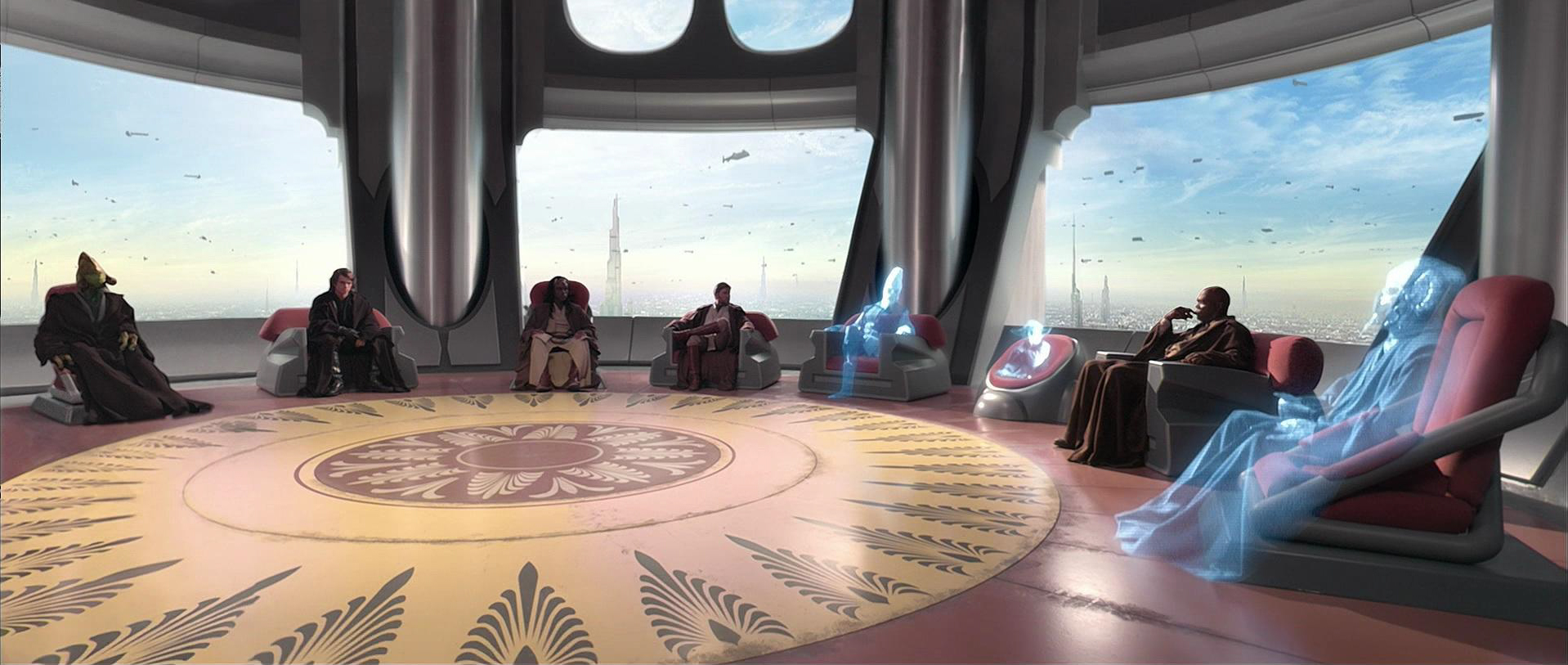
The High Council was disturbed by Chancellor Palpatine's decision to appoint Skywalker to their ranks.
In addition to the supplementary powers given to the chancellor by the Senate, the Council was even more disturbed by Palpatine's decision to appoint Skywalker as his liaison to the ruling body of the Jedi Order. Skywalker's appointment to the Council's ranks at his age was unprecedented; he would be the youngest Jedi to serve on the Council, and although he was counted among the finest warriors of the Order, he had not yet achieved the rank of Jedi Master. Despite their disdain at this move by Palpatine, the Council grudgingly accepted his decision, but on a condition—Skywalker would have a seat on the Council, but not the rank of Master, making him the only Jedi to hold this distinction throughout the history of the Order. In truth, the Council only cooperated with the chancellor so that Skywalker would be in the ideal position to monitor Palpatine's activities. Skywalker, however, felt insulted at not being granted the rank of Master, and was unenthusiastic about his unofficial assignment, regarding espionage against the chancellor as an act of treason. Kenobi disagreed and asserted that the Council's loyalty was to the Senate rather than its leader, who managed to stay in office far beyond what his constitutional term limit would allow.
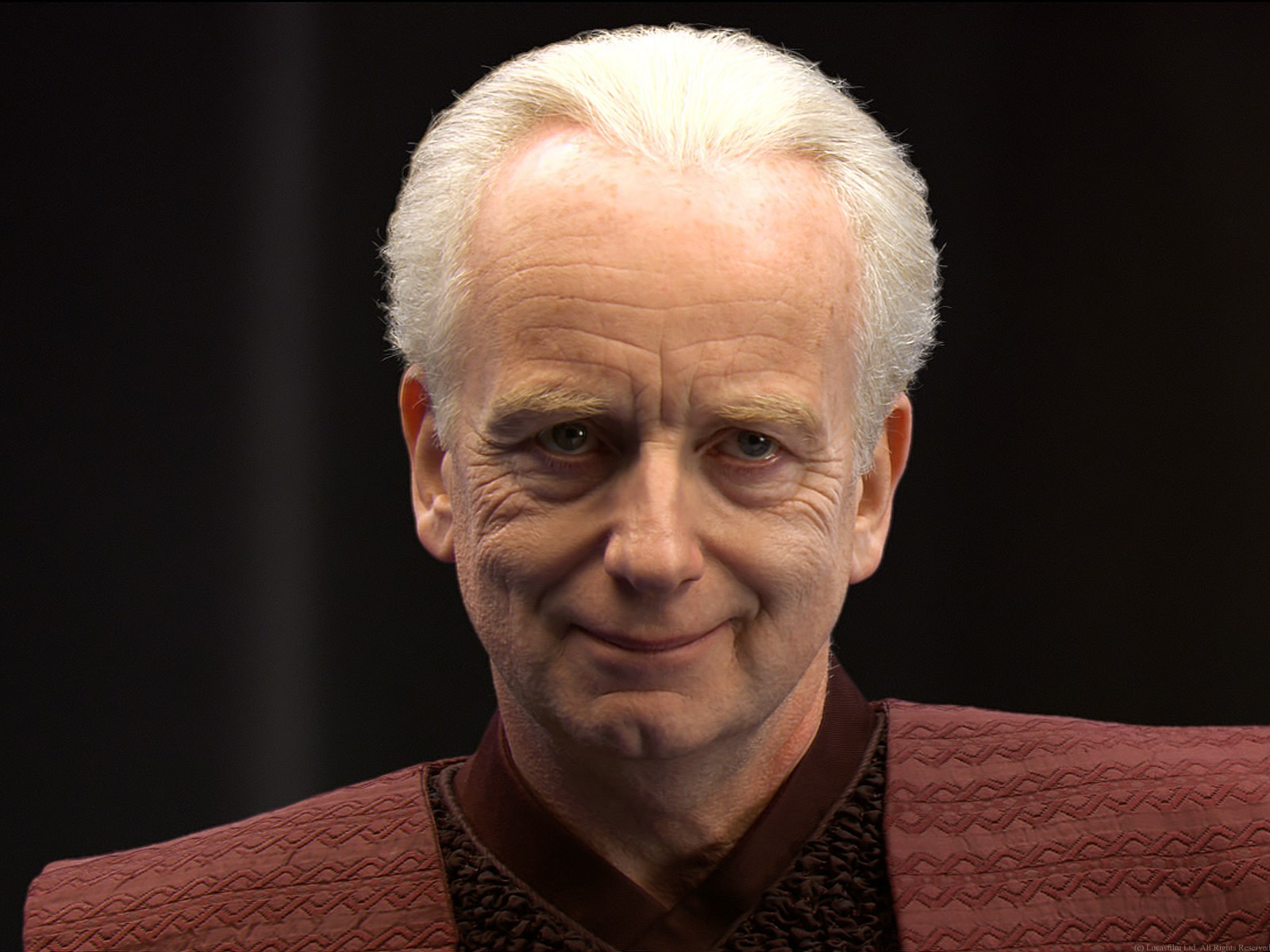
Chancellor Palpatine's increasing authority motivated the High Council to contemplate his removal from office.
After Clone Intelligence traced Grievous' position to Utapau, Skywalker informed the Council that the chancellor wished to place him in command of the mission to kill Grievous. Windu sternly informed him that the Council would decide who among their ranks would confront Grievous, regardless of Palpatine's opinion. Believing that a more experienced Jedi was required to bring the war to a decisive conclusion, the Council dispatched Kenobi and the 212th Attack Battalion. Yet even as the end of the war drew near, the Council remained skeptical about Palpatine's post-war intentions. Windu could also feel the dark side surrounding the chancellor, which caused him to suspect that a plot to destroy the Jedi Order was close to fruition. Frustrated by the chancellor's accumulation of power and the consequent erosion of the democracy that the Republic stood far, the Council began to regard him as a threat to the Republic. It was at this time that the Council started contemplating the possible necessity of forcibly removing Palpatine from office, an act which would necessitate a Jedi takeover of the Senate in order to maintain political stability during the transition to a new government.
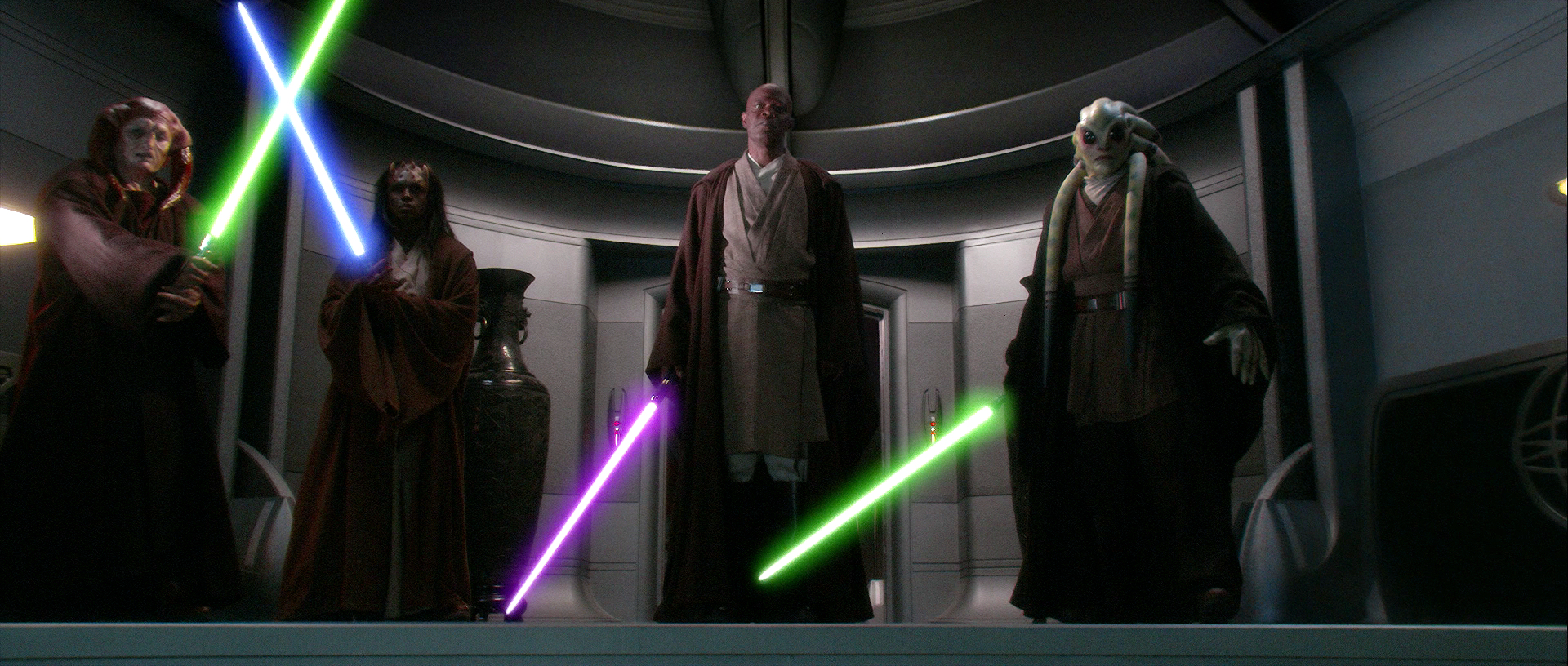
The fate of the galaxy was decided in a battle between the High Council and Darth Sidious.
Having groomed Skywalker as his future apprentice, Palpatine revealed his secret identity as Darth Sidious to the conflicted Jedi Knight who, in turn, reported Sidious to Windu. With his suspicions about the chancellor confirmed, Windu sought to save the Jedi Order from destruction by quickly removing Sidious from power. With the support of fellow Council members Kit Fisto, Agen Kolar, and Saesee Tiin, he marched into the chancellor's office and declared his intention to arrest Sidious in the name of the Senate, leading to a fierce lightsaber duel between the Dark Lord and the four members of the Jedi Council. Despite their own skills in lightsaber combat, the Jedi Masters Tiin, Kolar, and Fisto were slain by Sidious in quick succession. However, Windu was able to hold his own before ultimately emerging as the victor in the duel. By then, he believed that a trial would be useless as Sidious had gained control of the government, and therefore decided to put an end to his life in order to prevent the return of Sith oppression over the galaxy. Before he could deliver the killing strike, Skywalker, who had just arrived at the Senate Office Building, disarmed Windu, leaving him defenseless against the torrent of Force lightning that Sidious unleashed on him.
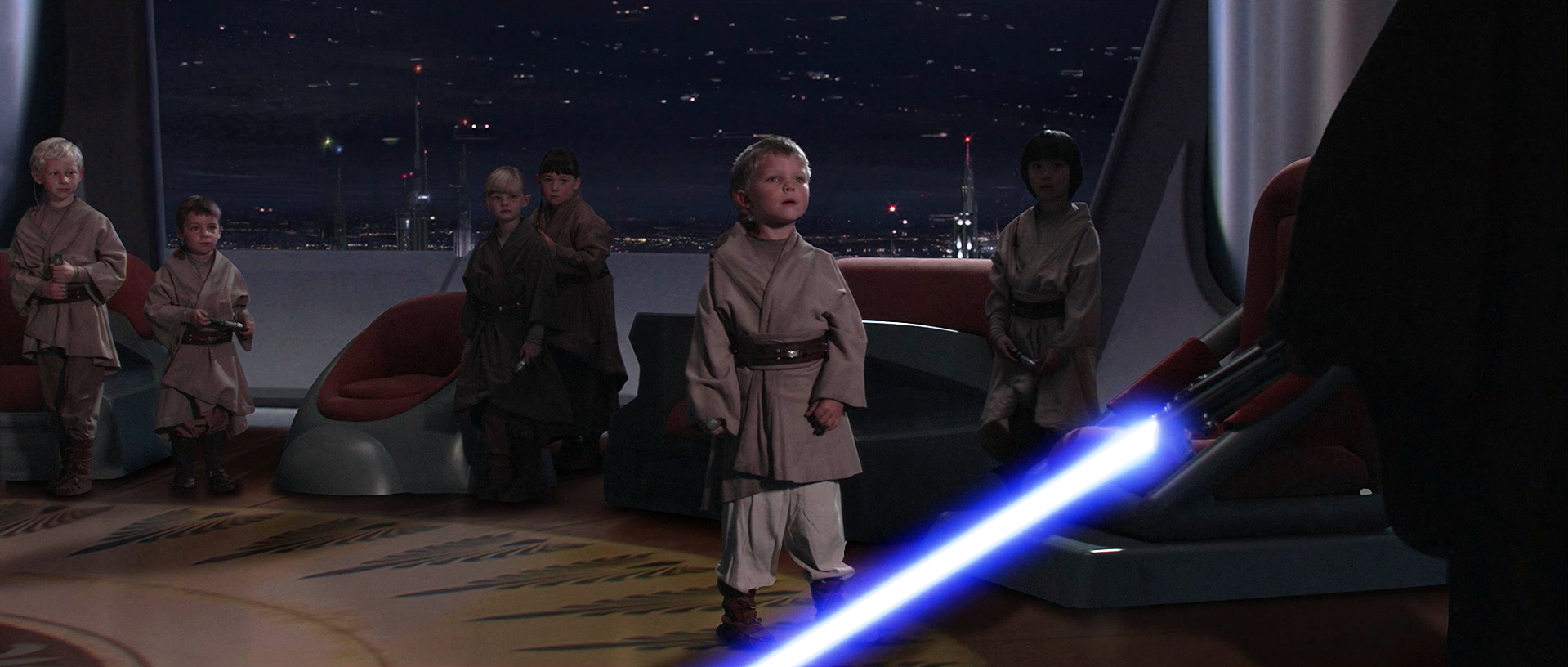
During the execution of Order 66, Darth Vader killed a group of Jedi younglings in the chamber of the High Council.
With the death of the Jedi Order's champion and the subsequent fall of Anakin Skywalker, who became Darth Vader, Sidious issued Order 66—a secret protocol that compelled the clone troopers to betray and murder their Jedi leaders. Aside from Yoda, Coleman Kcaj, Oppo Rancisis, and Kenobi, the remaining members of the Council perished along with the majority of the Order during the initial phase of the purge. During the siege of the Jedi Temple by the 501st Legion, a group of younglings hid in the Jedi Council Chamber where they were discovered and killed by Vader. Yoda and Kenobi returned to the Temple in the aftermath of its fall; after killing a garrison of 501st clones, the two Council members discovered Skywalker's role in the attack and ultimately his new allegiance as a Sith.
Kenobi confronted his former apprentice on Mustafar while Yoda challenged Sidious to a duel in the Galactic Senate Building. Neither Jedi succeeded in their efforts to destroy the Sith, although Vader sustained severe burns and the loss of his limbs, necessitating cybernetic surgery and a suit of armor to ensure his survival. The Jedi Masters separated in the ensuing Imperial Era with Yoda exiling himself to Dagobah and Kenobi becoming a hermit on Skywalker's homeworld of Tatooine.
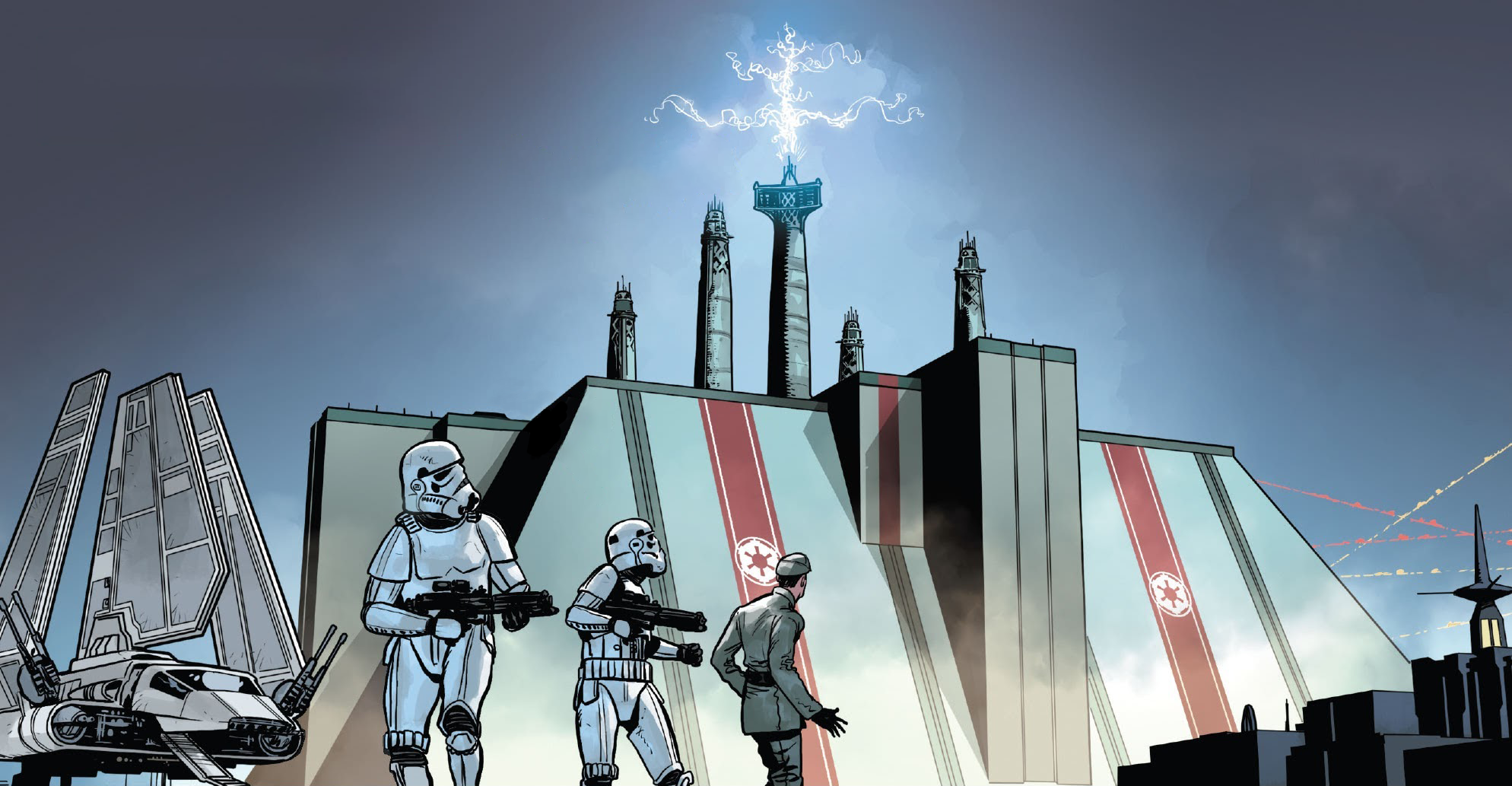
The former home of the Jedi Order and its High Council was turned into the palace of Emperor Palpatine.
Having purged the Jedi Order and its leadership, Sidious proclaimed the birth of a New Order, the First Galactic Empire that he would rule under the title of Galactic Emperor. The Jedi Temple was renamed as the Imperial Palace, becoming the personal residence of Emperor Palpatine, and the Jedi Council Chamber was repurposed to serve as his private office.
The influence of the High Council's legacy echoed through the knighting ceremony; Cere Junda recited a ceremonial quote while knighting Padawan Cal Kestis, recalling the High Council's right to bestow the rank of Jedi Knight to apprentices who passed their trials. An apparition of the Grand Inquisitor, who was once a Jedi Temple Guard, conferred the status of Jedi Knight on former Padawan Kanan Jarrus in the name of the High Council.
In 0 BBY, the same year as the Battle of Yavin, Luke Skywalker—the son of Anakin Skywalker—began his training in the Jedi arts under Obi-Wan Kenobi. Although Kenobi was killed by Darth Vader during the rescue of Princess Leia Organa, Skywalker remained determined to follow in his father's example and become a Jedi Knight. Guided by the spirit of his first Jedi Master to the world of Dagobah, Skywalker sought out Grand Master Yoda who agreed to complete his training, despite harboring concerns about the similarities between Luke and Anakin. With Yoda's help, Skywalker honed his nascent powers in the Force and was deemed to be fully trained by the Grand Master on his deathbed. However, before Skywalker could be considered a true Jedi, Yoda declared that he had to defeat his father, Darth Vader.
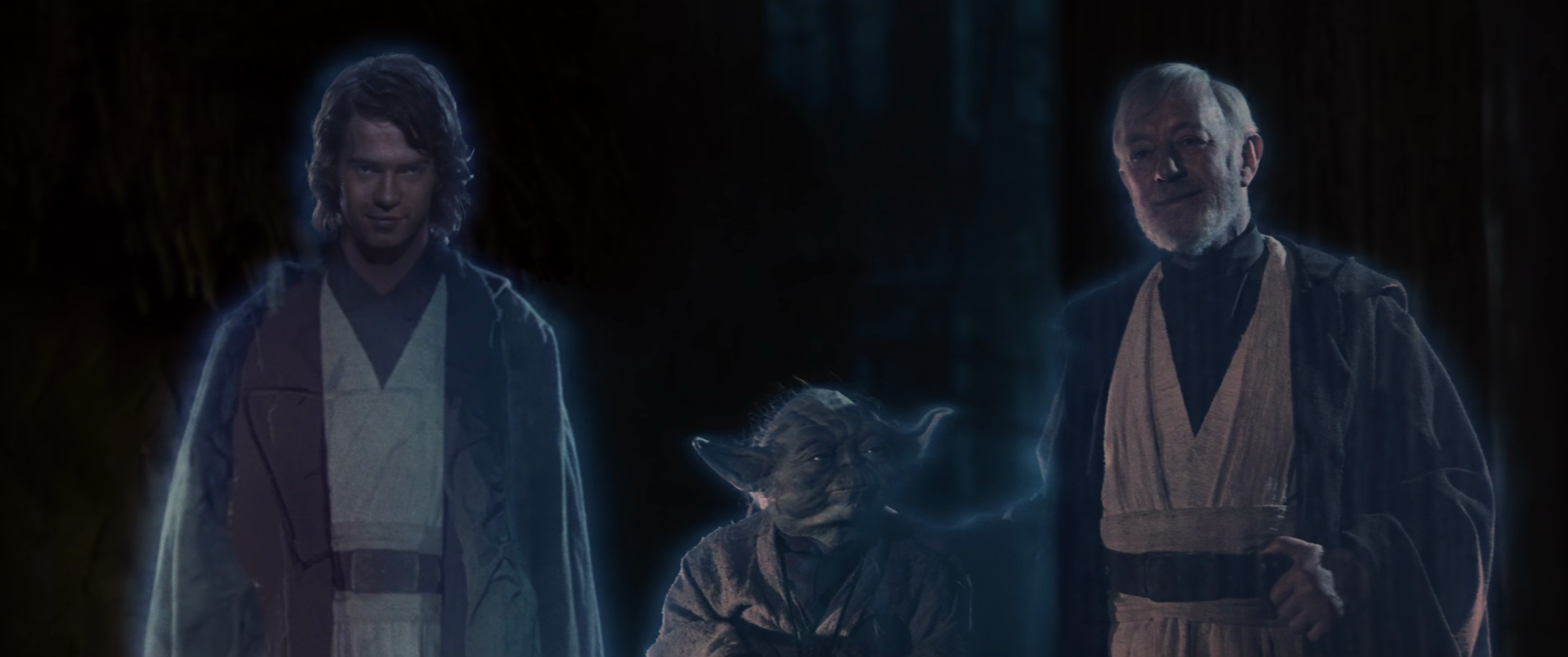
His destiny fulfilled, Anakin Skywalker joined his fellow council members in death as a spirit in the Force.
Their final battle ended with Skywalker's victory over Vader. Resisting the dark side, Skywalker spared his father's life and refused to take his place as Sidious' apprentice. When the Emperor proceeded to torture Skywalker for his rejecting the Sith, Vader moved to save his son in an act of self-sacrifice that ended with the destruction of both master and apprentice, ending the Sith lineage that began with Darth Bane and fulfilling the prophecy of the Chosen One. In the aftermath of the Battle of Endor, Luke Skywalker saw the spirits of his late father, Obi-Wan Kenobi, and Yoda—all members of the Jedi High Council—standing beside each other as the Alliance to Restore the Republic celebrated its victory on Endor.
According to Dave Filoni, supervising director of both Star Wars: The Clone Wars and Star Wars Rebels animated television series, one of the reasons for Anakin Skywalker's turn to the dark side was the lack of compassion and care of the Jedi. Ezra Bridger, the central character of Star Wars Rebels, however, had a very strong family support system by the people around him even though he could be tempted by the dark side. The novel The Living Force was written to touch on how out of touch the Council was with the wider galaxy during the later years of the Republic, featuring Qui-Gon Jinn effectively demanding they "touch grass" by interacting with people off of Coruscant.
- Star Wars: Jedi Temple Challenge — "Episode 1"
- William Shakespeare's The Phantom of Menace: Star Wars Part the First
- William Shakespeare's The Clone Army Attacketh: Star Wars Part the Second
- William Shakespeare's Tragedy of the Sith's Revenge: Star Wars Part the Third
- LEGO Star Wars: Droid Tales — "Exit from Endor"
- LEGO Star Wars: Droid Tales — "Crisis on Coruscant"
- LEGO Star Wars: The Skywalker Saga
- LEGO Star Wars: Choose Your Side: Doodle Activity Book